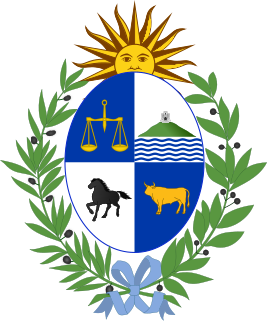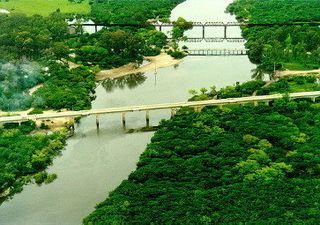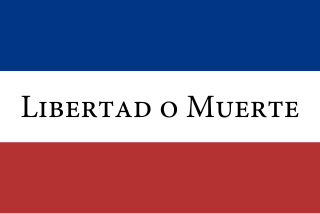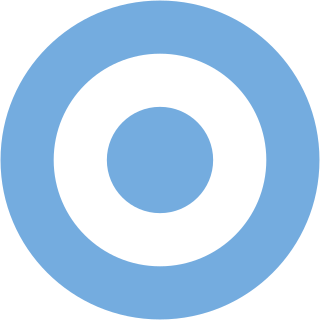
The flag of France is a tricolour flag featuring three vertical bands coloured blue, white, and red. It is known to English speakers as the French Tricolour or simply the Tricolour. The Tricolour has become one of the most influential flags in history, with its three-colour scheme being copied by many other nations, both in Europe and the rest of the world, and, according to the Encyclopædia Britannica has historically stood "in symbolic opposition to the autocratic and clericalist royal standards of the past.

The flag of Poland consists of two horizontal stripes of equal width, the upper one white and the lower one red. The two colours are defined in the Polish constitution as the national colours. A variant of the flag with the national coat of arms in the middle of the white stripe is legally reserved for official use abroad and at sea. A similar flag with the addition of a swallow-tail is used as the naval ensign of Poland.

A cockade is a knot of ribbons, or other circular- or oval-shaped symbol of distinctive colours which is usually worn on a hat.

The flag of Argentina is a triband, composed of three equally wide horizontal bands coloured light blue and white. There are multiple interpretations on the reasons for those colors. The flag was created by Manuel Belgrano, in line with the creation of the Cockade of Argentina, and was first raised at the city of Rosario on February 27, 1812, during the Argentine War of Independence. The National Flag Memorial was later built on the site. The First Triumvirate did not approve the use of the flag, but the Asamblea del Año XIII allowed the use of the flag as a war flag. It was the Congress of Tucumán which finally designated it as the national flag, in 1816. A yellow Sun of May was added to the center in 1818, which according to anarchist Diego Abad de Santillán, the sun represents the Incan god of the sun Inti., but its true symbolism is a matter or debate between vexillologists.

The national flag of Uruguay is one of the three official flags of Uruguay along with the flag of Artigas and the flag of the Treinta y Tres. It has a field of nine equal horizontal stripes alternating white and blue. The canton is white, charged with the Sun of May, from which 16 rays extend, alternating between triangular and wavy. The flag was first adopted by law on December 16, 1828, and had 19 stripes until July 11, 1830, when a new law reduced the number of stripes to nine. The flag was designed by Joaquín Suárez.

Uruguay consists of 19 departments. Each department has a legislature called a Departmental Board. The Intendente is the department's chief executive.

In vexillology, a state flag is either the flag of the government of a sovereign state, or the flag of an individual federated state.

A roundel is a circular disc used as a symbol. The term is used in heraldry, but also commonly used to refer to a type of national insignia used on military aircraft, generally circular in shape and usually comprising concentric rings of different colours. Other symbols also often use round shapes.

The coat of arms of Uruguay or Uruguayan shield was first adopted by law on March 19, 1829, and later on had some minor modification in 1906 and 1908. It was supposedly designed by Juan Manuel Besnes Irigoyen (1788–1865).

Treinta y Tres is the capital city of the Treinta y Tres Department in eastern Uruguay.

The Flag of Artigas is one of the three official flags of Uruguay. It pays homage to José Gervasio Artigas, the national hero of Uruguay. It has three horizontal stripes, the top and bottom being blue, and the central one white. On top of them, it has a diagonal red stripe.

The Flag of the Treinta y Tres is one of the three official flags of Uruguay, along with the National Flag of Uruguay and the Flag of Artigas.
The Treinta y Tres Orientales was a militant revolutionary group led by Juan Antonio Lavalleja and Manuel Oribe against the Empire of Brazil. Their actions culminated in the foundation of modern Uruguay. They became famous by the name of the Treinta y Tres Orientales when, in 1825, they began an insurrection for the independence of Oriental Province, a historical territory encompassing modern Uruguay and part of modern Brazilian Rio Grande do Sul State, from Brazilian control.

The Argentine cockade is one of the national symbols of Argentina, instituted by decree on February 18, 1812 by the First Triumvirate, who determined that "the national cockade of the United Provinces of the Río de la Plata shall be of colours white and light blue [...]".

The Federal League or League of Free Peoples was an alliance of provinces in what is now Uruguay, Argentina and Brazil that aimed to establish a confederal organization for the state that was emerging from the May Revolution in the war of independence against the Spanish Empire.

Cordón is a central barrio of Montevideo, Uruguay, located directly East of the Centro. Its main avenue is 18 de Julio Avenue. It is delimited by Miguelete Str. and La Paz Str. to the North, Dr. Barrios Amorin Str. to the West, Canelones Str. to the South and Dr. Joaquin Requena Str., and Rivera & Artigas Avenues to the East.
The National Routes of Uruguay are the most important transport routes in the country, linking all locations. It has a network of 8,698 km of which 303 km are with concrete, asphalt 3,164 km, 4,220 km bituminous and 1,009 km rough.

The 18 May 1811 Medal is the second highest military decoration of the Uruguayan Army. The medal was established 16 December 1997 to complement the Medal of Military Merit, the highest decoration of the Uruguayan Army, and commemorates the Battle of Las Piedras which took place on that date. The medal is presented in three classes and are awarded based on the rank of the recipient. The medal is awarded to Uruguayan and foreign military officers, as well as civilians, for outstanding achievement and meritorious service.

The cockade of France is the national ornament of France, obtained by circularly pleating a blue, white and red ribbon. It is composed of the three colors of the French flag with blue in the center, white immediately outside and red on the edge.


















